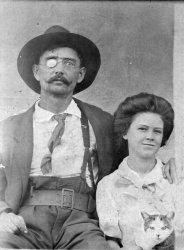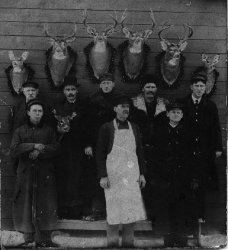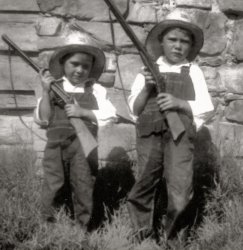
MAY CONTAIN NUTS

Search Shorpy
SHORPY ART

Framed or unframed, desk size to sofa size, printed by us in Arizona and Alabama since 2007. Explore now.
Join and Share
Ad-Free Shorpy
Shorpy is funded by you. Patreon contributors get an ad-free experience.
Learn more.

Recent comments
- Alas, hidden from view
- Exclusive pump
- Details, Details
- What's that building to the left of the tower?
- Coal Barges
- Bromo-Seltzer
- Inner harbor
- The Basin
- What a headache!
- Giant stepladder?
- Baldwin 62303
- Baldwin VO-1000
- Cold
- No expense spared
- Tough Guys
- Lost in Toyland
- And without gloves
- If I were a blindfolded time traveler
- Smoke Consumer Also Cooks
- Oh that stove!
- Possibly still there?
- What?!?
- $100 Reward
- Freeze Frame
- Texas Flyer wanted
- Just a Year Too Soon
- WWII -- Replacing men with women at the railroad crossing.
- Yes, Icing
- You kids drive me nuts!
- NOT An Easy Job
Member Photos
The Shorpy
Print Emporium
Print Emporium
Search Shorpy
Search results -- 30 results per page
- The Nursery: 1915
- ... Fishing is the state pastime in Minnesota (along with hunting). Kids had to be indoctrinated from the cradle . . .
And There Is ... Posted by Dave - 11/05/2014 - 8:40pm -
![The Nursery: 1915 "Nursery" is all it says on this 4x5 inch glass negative, which comes to us from a seller in Minnesota. Maybe someone with the right connections could run a check on these fingerprints. Probably from around 1910-1920. View full size.
Nursery AccoutrementsPaint (lead, no doubt) chipping off cribs, screwdrivers and awls on changing table, picture of dead fish on the wall. What a lovely nursery!
RunawaysI am sure the children ran away. The place is a deathtrap and the still life on the wall is enough to make me run.
Nasty cribsWidely spaced bars, probably painted with lead. Tools on the dresser, pictures of fish on the wall.
Looks like a nursery from a horror movie.
It Looks Fishy To Me.Is that a picture of dead fish on the wall next to the mirror?
[As noted below by the cultured Kait, that is a STILL LIFE. - Dave]
FingerprintsThe nanny did it. No, wait -- the nurse. Okay, then -- the photographer.
Nursery of the NastyIt is hard to believe that our ancestors made it through things like this to allow us to be born! Scary!
The devil you say!This is where Rosemary had her baby.
Looks like a nursery from a second-rate orphanage.Linen on the beds is clean, but the beds themselves are shabby. Too many clothes apparently hung up on pegs in the closet.
[I wouldn't go anywhere near those beds without a tetanus shot. -Dave]
Early indoctrinationFishing is the state pastime in Minnesota (along with hunting). Kids had to be indoctrinated from the cradle . . .
And There Is the ClosetWhence the monsters emerge at night.
Despite the Negative CommentsI wouldn't mind having one of those wrought-iron cribs to refinish. The brass work on them was quite nice, too.
On the other hand, I wouldn't be saying, "Bloody Mary" three times in that mirror!
(The Gallery, Found Photos, Kids)](https://www.shorpy.com/files/images/SHORPY-141105-0006.thumbnail.jpg)
- Pride of Plates: 1940
- ... to me. Whether from a grandparents' house or visiting a hunting cabin or two. The people of the Depression did not get rid of anything. ... Posted by Dave - 09/12/2020 - 5:59pm -
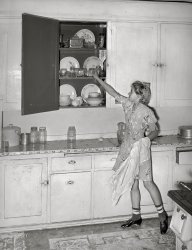
- Bunny Hunter: 1908
- ... 4 years at Dillon Mills. Gets 50 cents a day. Had been out hunting." Photograph and caption by Lewis Wickes Hine. View full size.
... Posted by Dave - 05/17/2014 - 11:32pm -
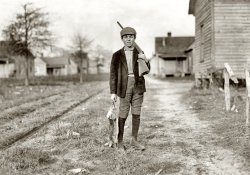
- 4 Seconds Fast: 1943
- ... wall in my hallway! My parents had the picture of the hunting dog (along with three others, forming a set) for as long as I can ... Posted by Dave - 05/01/2014 - 1:27pm -
![4 Seconds Fast: 1943 March 1943. More Marceline, Missouri. "A dispatcher at work in the Atchison, Topeka & Santa Fe Railroad offices." This fellow would seem to be sensitive to glare. Photo by Jack Delano for the Office of War Information. View full size.
FastThe clock says it's four second fast. I wonder how they (a) know and (b) at what point do they correct it?
Walt DisneyThe Marceline depot is now the Walt Disney Hometown Museum.
http://www.waltdisneymuseum.org/museum/
Judging by the window (double hung sash with a small transom), I would say that it is indeed the same building.
Standard TimeUnder the TT&TO (Timetable and Train Order) system of train operation used by railroads for over a century, timing was critical to keep trains from running into one another. Every railroad had one very accurate "Standard Clock". Every employee whose duties were affected by the TT&TO Rules had to carry a railroad watch, certified annually by an approved jeweler to be accurate to not vary more than 30 seconds per week. Each employee starting on duty was required to compare his watch to a local standard clock at that station, and if it varied more than 30 seconds from the standard to correct it. Each station, the local standard clock had to be compared by telephone or telegraph to the Standard Clock, and if it varied by more than 30 seconds it had to be corrected.
I have that picture on the wall in my hallway!My parents had the picture of the hunting dog (along with three others, forming a set) for as long as I can remember, until they gave them to me back in 1992. I've had them on the wall in my house ever since. One, sadly, was damaged ten years ago when the 1930s era frame simply fell apart suddenly and it crashed down, smashing the glass and slicing the print. The others are still hanging on the wall in our hallway.
Standard Time ZonesWere initially set up by the railroads. Before that each city or region could set its own time and that caused chaos with railroad schedules, and safety.
Housekeeper's holidayBased on this photo, the feather duster must have been invented in 1944.
What gives? It appears as if some major changes were made in this office during March of 1943. Comparing the current image with the previous, we see: 1) the telegraph key has either been moved or eliminated, 2) “Mission Control” has the desk lamp over what appears to be a speaker device missing in “4 Seconds Fast: 1943,” 3) the standard clock is on one wall first, then another subsequently, and 4) in “4 Seconds” the dispatcher has what I’m guessing is a CTC board in front of him, absent in “Mission.” The one comforting constant is the sacred train sheet, spread from one end of the desk to the other. (Well, not so sacred anymore, as train movements are recorded and stored by computer software these days, not pen and ink…at least on Class 1 railroads.)
[The two pictures were taken within minutes of each other, and nothing has moved except the photographer. These are two different desks. - Dave]
Okay Dave, that makes sense. But your answer only raises two more questions: 1) why are there two desks for the same territory (a sure prescription for disaster), and 2) why does the "Mission" board go to Chicago from left to right, and the "4 Second" board go Kansas City (?) to Chicago right to left?
Face to FaceDave - your comment about being different desks is correct. In fact, they appear to be facing each other. Note the position and shape of the "poster board" tied to the pipe above them.
RE: left to right and right to left"why does the "Mission" board go to Chicago from left to right, and the "4 Second" board go Kansas City (?) to Chicago right to left?"
I would guess that "4 Seconds Fast" guy is seated facing south with Chicago to his left and "Mission Control" guy is facing north.
(Technology, The Gallery, Jack Delano, Railroads)](https://www.shorpy.com/files/images/SHORPY_8d26441u.thumbnail.jpg)
- Andy at Home: 1962
- ... near Albermarle Sound; deep sea fishing in the Sound; hunting with his dog; playing guitar and bass horn; plowing his field; speaking ... Posted by Dave - 10/23/2015 - 11:14am -
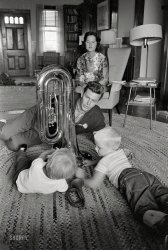
- California Rifles: 1908
- ... my first white-tailed mule deer in 1953. My wife's Mormon hunting pro relatives laughed at the idea that a kid from NYC wearing his ... Posted by Dave - 01/29/2016 - 4:47pm -
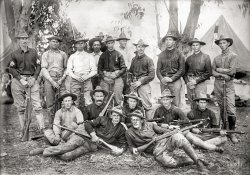
- Drawing Room 1920s
- ... how they are oriented.
I have gas lights in my hunting cabin and they point down.
Gas & Electric I've seen pages ... Posted by Joe - 09/22/2011 - 11:09pm -
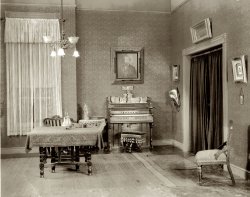
- Jersey Shore Jesus: 1908
- ... Shifting Sands.
Atlantic City has become the happy hunting ground of the sand sculptor. The vulgar populace there find nothing so ... Posted by Dave - 05/20/2011 - 5:43pm -
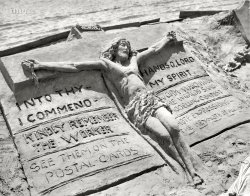
- American Gothic: 1923
- ... through D.C. just for the architecture but now one must go hunting to see anything interesting.
Fifth-floor walkup Isn't that ... Posted by Dave - 08/06/2012 - 1:57pm -
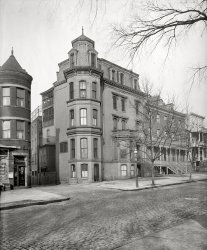
- Dog Cakes: 1910
- ... marketed to country gentlemen in England for their hunting dogs.
Production was relatively limited until after James Spratt's ... Posted by Dave - 08/15/2012 - 3:06pm -
![Dog Cakes: 1910 Utica, New York, circa 1910. "United Commercial Travelers of America building." On a block offering a cornucopia of goods and services: Dog Cakes (not to be confused with Twentieth Century Lunch three doors down), dog collars, bananas, cigars, an amusement arcade (the Shooting Gallery), coal, shoes, trunks and, finally, crockery and glassware. 8x10 inch glass negative View full size.
Close to homeThis building is now an apartment complex, but most of the buildings to the right are gone, lost in a massive fire in 1948. Among them was my father-in-law's store, just out of the picture. If you could pan to the right, I'd appreciate it!
[Done. - Dave]
OK I'll BiteWhat's a dog cake?
What better to eat with Dog Cakes butDog Milk!
I took this photo of a can of Dog Milk that I saw in a Restaurant where I was dining in Japan a few years ago.
I asked the waitress how many dogs had to be milked to get a whole can of Dog Milk, but she didn't seem to understand.
70 Genesee StreetIn 1905, the company needed more office space and moved to this building, at 70 Genesee Street in downtown Utica, within sight of the Erie Canal.
In 1937, the building was tripled in size to accommodate the needs of more than 200,000 policyholders.
View Larger Map
The lunch is up to dateI'm reassured. If they advertised a 19th Century lunch, it would be ten years past its expiration date. Which is only four years past the Pure Food and Drug Act.
Kid-Free Eatery"20th Century Lunch -- For Ladies and Gentlemen"
Penny ArcadeThat's a great view of an old penny arcade, taken at a time when many of the attractions actually did cost only one cent. At the doorway is what appears to be a 44-note piano. These were usually set up to play a tune for a nickel, although the operator could have set it to play continuously as a means to entice passersby to enter. Along the right wall can be seen a row of Mutoscopes similar to the ones in the photo below. These played a moving picture supplied by individual frames printed on cards and formed into a reel. Each real contained one short movie, and since each Mutoscope held only one reel, the arcade would have many Mutoscopes in order to offer a variety of movies.
"Dog Cakes" - No dogs addedSpratts "Dog Cakes" was the first mass-produced dog food. James Spratt came up with "Patented Meat Fibrine Dog Cakes" after seeing dogs eating hardtack biscuits. The biscuits were initially marketed to country gentlemen in England for their hunting dogs.
Production was relatively limited until after James Spratt's death. However, in the 1880s, the company went public and became one of North America's marketed company in the 20th Century. They were eventually bought out by Purina.
Charles Crufts, who founded the Cruft's Dog Show began as a clerk for Spratt's.
Spratt was secretive about the actual meaty ingredient in his "cakes" and early ads in England intimated it was buffalo.
(The Gallery, Dogs, DPC, Stores & Markets, Utica)](https://www.shorpy.com/files/images/4a19575a.thumbnail.jpg)
- I Am the Egg Boy: 1950s
- My cousin Stephen hunting Easter eggs at our grandmother's house in Anderson, Indiana. Probably ... Posted by bhappel - 04/11/2009 - 7:22pm -
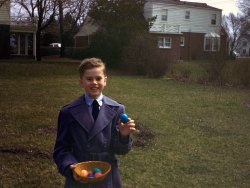
- Ladies Bathing Place: 1890s
- ... traits of a snark, as defined in Lewis Carroll's "The Hunting of the Snark":
The fourth is its fondness for bathing-machines, ... Posted by Dave - 02/04/2014 - 10:02am -
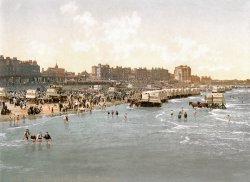
- On Vacation: 1969
- ... Nebraska. My family owns a "ranch" out there (really a hunting cabin). The tree on the upper right appears to be a Ponderosa pine, ... Posted by Mvsman - 09/18/2011 - 10:16pm -
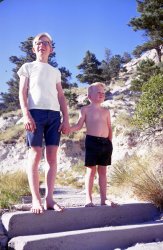
- Ruby, Alaska: 1915
- ... in Ruby live a Subsistance life of living off the land. Hunting, fishig and trapping. It is a simple life but honest and hard working. ... Posted by Dave - 09/24/2009 - 9:06pm -
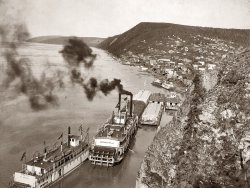
- Billy, Get Help!
- Circa 1900s. "Billy and his mistress in hunting poses." Our second look at this eight-part series awaiting the ... Posted by Dave - 11/26/2010 - 10:28pm -
![Billy, Get Help! Circa 1900s. "Billy and his mistress in hunting poses." Our second look at this eight-part series awaiting the colorist's brush. Note the pasted-on wound. 8x10 inch dry plate glass negative, Detroit Publishing Company. View full size.
Alternate caption"Billy's mistress checks his pulse before the hunt."
WoofThat dog is an excellent actor.
This serieskeeps getting more and more bizarre.
I still wonderWhat will be the final end use of these photos? I fully agree as to why they are photographed in this manner, I just have a hard time seeing this as advertisement material. I could be very wrong naturally, but what would they promote?
[Detroit Publishing didn't do advertising work as far as I know. Novelty postcards (example below) or decorative prints are more likely uses. - Dave]
Billy's mistressshoots the dog so she can steal his rings and Rolex. Because she's that kind of gal.
WhewI'm sure happy you told us that was a painted on wound! It looked so real I was worried! I guess that was as good as graphics got in 1900!! Great pic! Thanks!
(The Gallery, Dogs, DPC)](https://www.shorpy.com/files/images/4a16809a.thumbnail.jpg)
- Animal Farm: 1936
- ... drive. Herding dogs have been bred and taught to use their hunting instinct to control livestock. They know the sheep are food, just not ... Posted by Dave - 02/17/2013 - 11:06am -
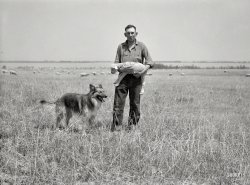
- You've Got Quail!
- ... size.
Are you sure this isn't Indiana Jones on a hunting spree?
Who, indeed? The dogs, most likely!
A question of ... Posted by Dave - 05/19/2014 - 2:15pm -
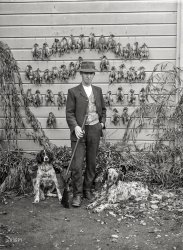
- Bunny Huggers: 1950
- ... windows and rustic furniture, I'm guessing this was a hunting fishing cabin.
Happy Easter fellow Shorpyites.
(Easter, Kids, ... Posted by Dave - 03/31/2018 - 4:41pm -
![Bunny Huggers: 1950 Somewhere in Wisconsin circa 1950. "Mike and Mr. Rabbit." Happy Easter weekend from Shorpy! 35mm Kodachrome slide. View full size.
By the labor of his handsGoing by the state of his shirtsleeves and his hands, Daddy works at a job that involves lots dirt and grease, so much that it won't come off no matter how he scrubs. (Perhaps a mechanic; a welder; a machinist.)
[Daddy is a professional who's building the cottage he's in. - Dave]
Hey, kids, what time is it?Does anyone else think Dad looks a little like Howdy Doody?
Definitely has the haircut for a Doody.Plus he's a two-ashtray man. When smoking was king.
Man cave?Could this be in dad's basement man cave? Cinder block walls with no paint. Stacks of wood/ moldings about the area. Pencil sharpener attached to the door jam. Definitely not the living room.
[wet_powder nailed it. It's the living room of a vacation cabin. - Dave]
Vacation CabinWith the unpainted block walls, shuttered windows and rustic furniture, I'm guessing this was a hunting fishing cabin.
Happy Easter fellow Shorpyites.
(Easter, Kids, Wisconsin Kodachromes)](https://www.shorpy.com/files/images/SHORPY-N4-014.thumbnail.jpg)
- Civil War Veterans: c. 1925
- ... He died in 1909 so he is not among the living. I too am hunting for photos. I will post anything I find!
re: GAR Post 97 Thanks ... Posted by D_Chadwick - 06/23/2011 - 6:37pm -
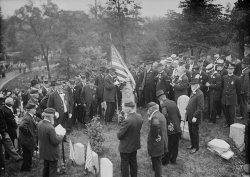
- Mansfield Quarters: 1936
- ... So was the dirt yards, gardens, chickens, and hogs, and a hunting dog or two.
The difference between Georgetown, SC and Miami, FL ... Posted by Dave - 07/08/2013 - 5:00pm -
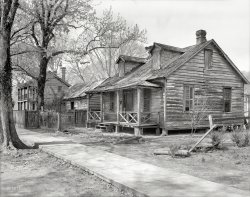
- Hawaii: 1965
- ... I was there many times in 1963-4; it was considered prime hunting ground for Marines stationed at MCAS Kaneohe, which was about an hour ... Posted by JoeV - 08/15/2012 - 3:52pm -
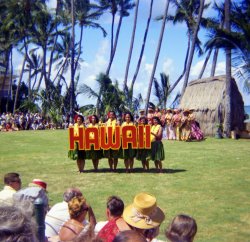
- Groundhog Day: 1939
- ... Back in the 1930's and 40's my family were hunting and fishing guides in the Lake Superior region, continuing an aspect of ... Posted by Dave - 02/02/2018 - 7:11am -
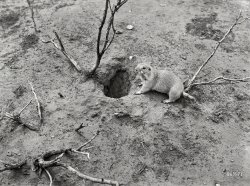
- Jamieson Brothers: 1910
- ... Milton, Frank and Jim, the Jamieson brothers, with their hunting dogs in 1910. I assume the squirrel was for supper. My grandfather, who ... Posted by vdcchilders - 08/29/2008 - 9:52pm -
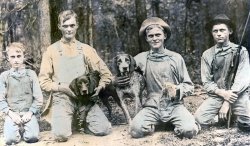
- Fearless Hunters: 1910
- Hunting party, 1910 around Mansfield, Ohio. View full size.
... Posted by pontoon - 01/17/2011 - 9:27am -
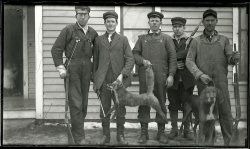
- Hunters in Hanover, Michigan
- ... hand of Barney Ramsdell. The men all appear to have long hunting coats. Four of the men appear to have white shirts and ties.
A.B. ... Posted by JudyKPfaff - 08/21/2007 - 9:52pm -
- Cedar Crest: 1931
- ... where I can't say. From the interior, it looks to be a hunting lodge or cabin of log construction, and I suppose those guys are local ... Posted by bhappel - 04/27/2011 - 2:22pm -
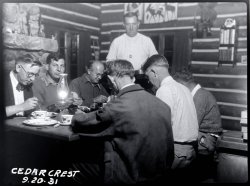
- Cabin Cookie
- From a series in my negatives collection titled "Hunting Cabin." Can't read the brand of the stove too well, but it dates from ... Posted by mhallack - 01/10/2014 - 9:06pm -
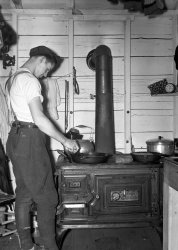
- Young Hunters, 1938
- Dad and his brother began hunting at a very early age. This photo, from 1938, shows two little boys who ... Posted by niceleyj - 11/08/2008 - 11:31pm -
- I Got Dinner!
- From the hunting cabin series. This is a successful deer hunter. Hopefully he didn't ... Posted by mhallack - 01/10/2014 - 9:06pm -
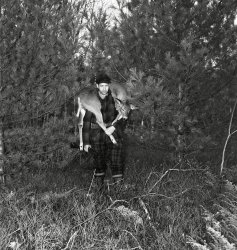
- Ben, Camilla & Cat: 1909
- ... Tree, Arkansas in 1909. Ben had lost his right eye in a hunting accident on the St. Francis River when he was younger. In this photo ... Posted by GChandler - 10/17/2017 - 4:00pm -
